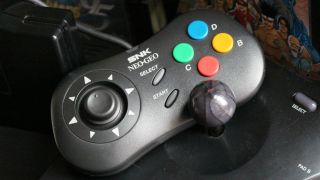The ultimate mega shock: the story of the legendary Neo Geo
Premium gaming at a premium price

If you turn your nose up at the cost of video gaming in the modern era, with its rising software prices, expensive accessories and exploitative mid-cycle system upgrades, then it's almost certain that you never owned SNK's wallet-busting early '90s console, the Neo Geo.
Launched alongside the likes of the Sega Mega Drive and Super Nintendo, it was quickly dubbed 'The Rolls Royce of gaming systems' by the specialist press of the period – a fitting monicker given the incredible specs and outlandish cost of ownership associated with what was then the most powerful home console available.
SNK – short for Shin Nihon Kikaku Corporation – was one of many Japanese companies that had benefitted from the arcade explosion of the 1980s, but it had grander plans than simply pumping out a series of coin-op hits and licensing them for console conversions.
The aim was to conquer both amusement centres and the home market, and to achieve the first of those goals SNK created its own arcade standard, known as MVS, or Multi Video System.

Offering cutting-edge power and robust, easily interchangeable cartridges, MVS quickly found favour with amusement operators who were keen on reducing their reliance on expensive and often fragile arcade boards.
The 'domestic' part of the strategy, meanwhile was the AES – short for Advanced Entertainment System – which was a home console based on the exact same technology. SNK was doing the unthinkable: shrinking down a powerful coin-op cabinet for your living room.
The appeal of this concept was simple. Instead of having to make do with scaled-down domestic ports blighted by missing animation, cut content and weaker presentation, Neo Geo AES owners would benefit from truly perfect ports of the latest and greatest arcade releases.
Get daily insight, inspiration and deals in your inbox
Get the hottest deals available in your inbox plus news, reviews, opinion, analysis and more from the TechRadar team.

The games were entirely identical, with each title having coin-op and domestic settings to suit both environments. The key difference was the cartridges themselves; while both standards contained the same code, the connectors were engineered to be incompatible, to prevent naughty arcade operators from buying the cheaper AES variants and using them in their cabinets.
A console for the one percent
Of course, when it comes to the world of Neo Geo the term 'cheaper' is relative. Even though AES editions were priced lower than their MVS equivalents, they still retailed for around £200/$200 a pop, while the console itself cost approximately £450/$650. To put those prices into perspective, back in 1992 the Sega Mega Drive cost £125/$190 with Sonic the Hedgehog, while the SNES retailed for £150/$199.
It goes without saying that from the off the Neo Geo was a niche platform, despite the incredible amount of coverage it received in gaming magazines of the time.
The console's notoriety was enhanced further by the fact that in the arcades, SNK's games – such as Fatal Fury, Art of Fighting and Samurai Shodown – were growing in popularity to the point where they were being ported to other home systems, with mixed results. The Neo Geo was seen as the only way to play these must-have titles, but it was out of the price range of all but the most affluent gamer.
- Welcome to TechRadar's Console Gaming Week, celebrating each and every pixel of video gaming greatness. Head over to our hub to see what you've missed so far.
